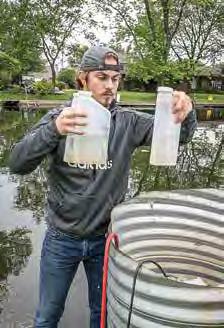
2 minute read
Water Health
photo by Mike Deak WACF: Working for Cleaner Waters
by Beth Morris, chairman of WACF’s Ecology Committee
We’ve all heard the old adage, “an ounce of prevention is worth a pound of cure.” The adage is applicable to our area lakes, as well. When we really think about life at the lake—families, traditions, recreation, renewal—we realize that the water quality of our lakes is, indeed, a precious commodity.
We need look no farther than Grand Lake Saint Marys (Ohio) or Lake Erie to see the negative impact that excess nutrients and sediment have on water quality. The Wawasee Area Conservancy Foundation (WACF) believes it’s important to be proactive in understanding what is happening with regard to the natural aging process in our lakes, and to take action to help these efforts. As such, WACF has implemented on-the-ground conservation projects, forging partnerships, and helping people understand how to help keep our beautiful lakes clean for future generations.


Restoration projects
Since 1991, WACF has completed 20 remediation/restoration projects in the watershed. A study commissioned several years ago revealed there are 99 critical areas of the watershed that need remediation, 29 of which are ‘hot spots.’ Our dilemma: how to prioritize those projects to get the most ‘bang for the buck’ in reducing incoming sediment and nutrients.
Meet WINS
The best way to answer this is with a data-intensive three-year landmark study known as WINS (Wawasee Inlets Nutrient Study).
WINS began in 2019 and is providing detailed data on how much nutrients and sediment are entering Lake Wawasee from each of its five inlet streams, and exiting at the Syracuse Dam. To do this, WACF contracted with Ecosystems Connections Institute, headed by Dr. Jerry Sweeten, professor emeritus of environmental studies at Manchester University, to design and carry-out the study.
Using high-tech automatic samplers, each of the six streams are sampled intensively every 4 hours, from April through June (these months were selected as they are when the land is most vulnerable, due to agricultural activity and spring rainfall). In the remaining months of the year, each stream is sampled weekly.
Stream-flow and rainfall are measured, correlated to the individual sample points, and the resulting data is extensively, statistically analyzed.
In 2019, 2,945 samples were taken and 18,359 individual nutrient and sediment tests were run. This multi-year, intense sampling approach will accurately show the levels of nutrients and sediment contributed to the lake by each tributary.
WACF will use this data to prioritize future remediation projects that are aimed at the goal of ‘shutting off the tap’ of excess nutrients and sediment entering Lake Wawasee.
The Wawasee Area Conservancy Foundation (WACF) is a local, public foundation dedicated to the preservation and enhancement of the Wawasee area watershed for present and future generations.
Beth Morris is chairman of WACF’s Ecology Committee and on the Board since 2016. She and her committee have been the driving force behind the datadriven Wawasee Inlets Nutrient Study (WINS) with Dr. Jerry Sweeten. She spent 29 years with Eli Lilly and Company in pharmaceutical manufacturing, quality assurance, and project management for new product development.











